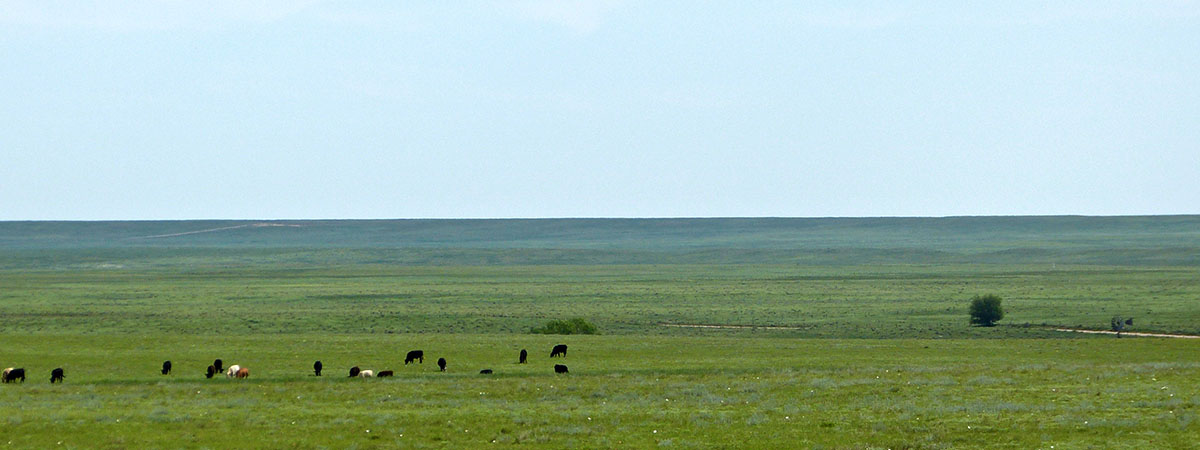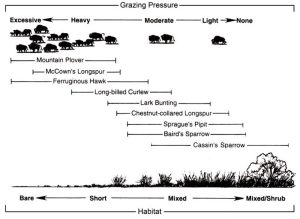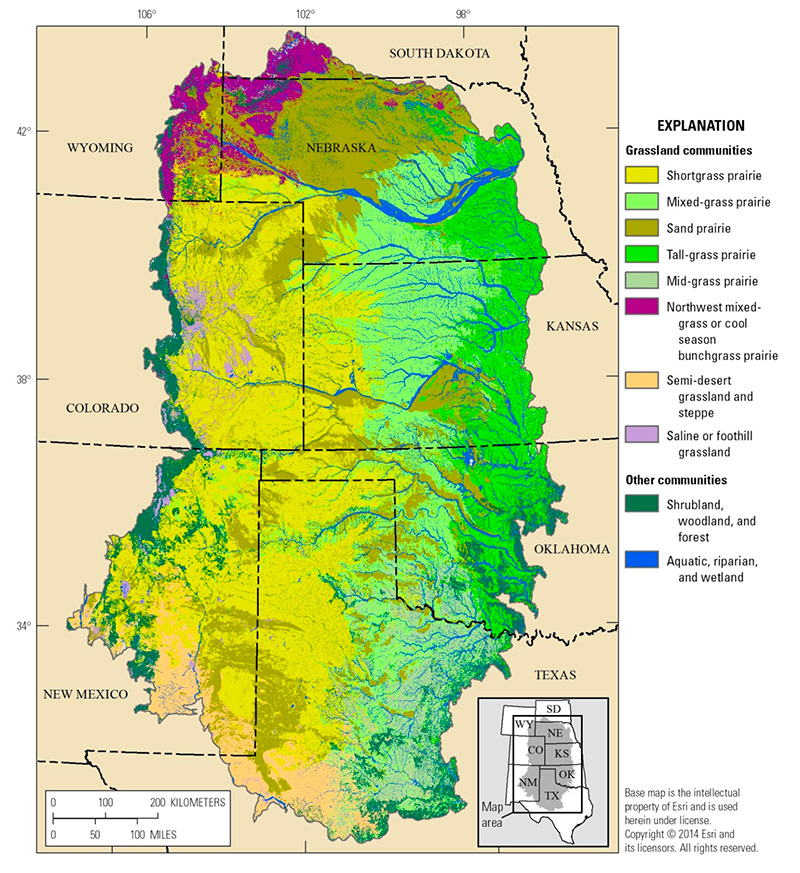
Estimated historical distribution of grassland and adjacent communities. Click to enlarge. Credit: U.S. Geological Survey.
Much of the shortgrass and central mixed-grass prairies of the western Great Plains — which provide critical habitat for birds and important working lands for people — occur within the PLJV region. However, grasslands are one of the most threatened ecosystems in North America, and grassland birds are experiencing some of the most significant population declines.
Currently, about 36% of our landscape, or 57 million acres, are in grass including rangeland and Conservation Reserve Program (CRP) lands; however, that number is greatly reduced from pre-settlement times. Historically, approximately 90% of this landscape was in grass.
While it may sound like grasslands in our region are all similar, the prairie is very nuanced. It is composed of many different plants that create a gradient of short, medium, and tall grasses from west to east. Climate is the primary driver in shaping the plant structure. The average amount of rainfall ranges from an annual average of 10 inches in the western part of our region to 30 inches in the east. As you can see from the map, that creates a gradient of plant communities corresponding to the change in climate, as well as the underlying geology and other varying conditions — from patches of bare ground to areas mixed with native shrubs — that create a mosaic of habitat types.
These grasslands support more than 600 species of birds and other wildlife, which have adapted to living in these different conditions. The figure to the left, from a 1996 book chapter about prairie birds by Fritz Knopf, illustrates bird response to different grassland structures. Historically, varying prairie conditions were created naturally by grazing bison, prairie dog communities, and fire. Today, ranchers and land managers often use rotational grazing and prescribed fire to replicate those conditions.
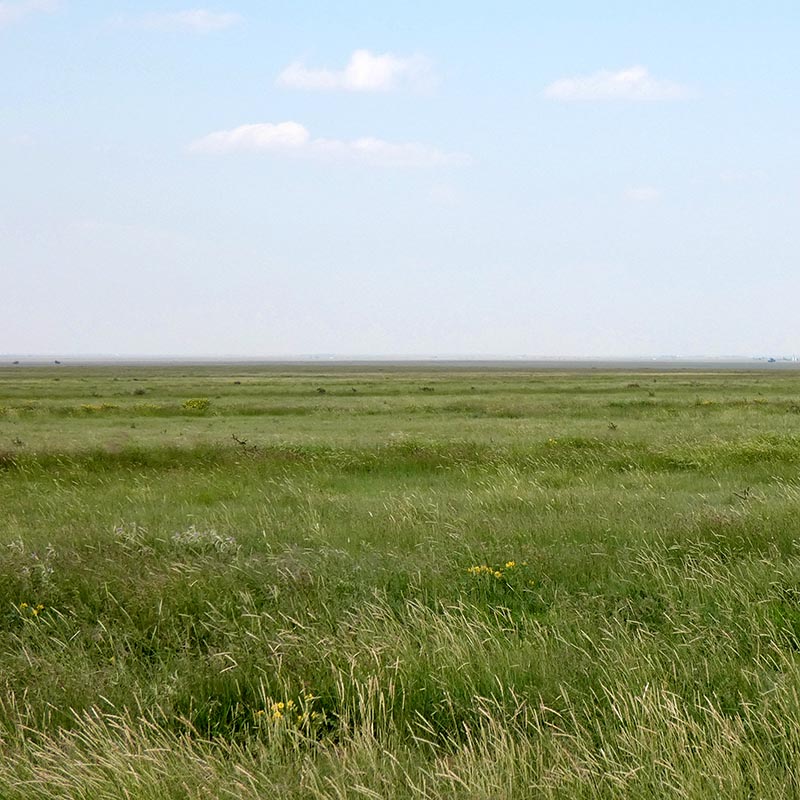
What Is a Healthy Grassland?
A healthy grassland is one with diverse native plant communities, primarily grasses with a mixture of forbs and small shrubs.
Trees are generally not part of a grassland system, although they may be found on the edges of grasslands, such as in canyons or draws, or along rivers. Grasslands are free of harmful invasive plants, including several species of woody plants, non-native grasses, and forbs.
With prairie plants, there is as much or more below the ground as there is above. The plant roots provide rich micro-environments that support insects and mammals — which in turn sustain other wildlife above the ground — and play an important role in providing clean air and water through carbon sequestration and water filtration.
As you’ll see below, grasslands not only provide critical habitat for wildlife, they are also important for the people who live in this region.
Wildlife Habitat
Hundreds of wildlife species make their home in the grasslands of the western Great Plains. Endemic grassland birds — like the Lesser Prairie-Chicken, Upland Sandpiper, and Thick-billed Longspur — perform fascinating breeding displays every spring. Historically, vast herds of American bison roamed widely across the prairies and, through their grazing, maintained the diversity of grassland structure required for these and other birds. Black-tailed prairie dogs are also unique ecosystem engineers creating specialized habitat within their expansive towns for a subset of prairie specialists such as black-footed ferrets, swift fox, burrowing owl, and mountain plover.
Rangeland
Many of the large blocks of native grass are found on ranches, and maintaining these rangelands is integral to preserving grasslands in our region and keeping working lands working. The Great Plains has a deeply-rooted ranching heritage, and this lifestyle goes hand-in-hand with land stewardship and conservation. The future of our grasslands will depend on the ranching community and their ability to meet and adapt to today’s challenges.
Carbon Sequestration
Grasslands absorb carbon dioxide and primarily store it in the roots, which are significantly longer than the grasses themselves. Even a short plant such as buffalo grass can have roots that grow six feet or longer.
Water Quality
Grasses help clean surface water and reduce soil erosion into nearby wetlands. The roots help maintain the structure of wetlands, rivers, and streams — which is especially important during rainstorms — by keeping runoff from eroding soils and creating channels in the grasslands.
Pollinators
Grasslands support thousands of pollinator species, including bees, birds, and butterflies. In the United States, wild pollinators provide services estimated at four to six billion dollars annually.
Quick Facts About Grasslands
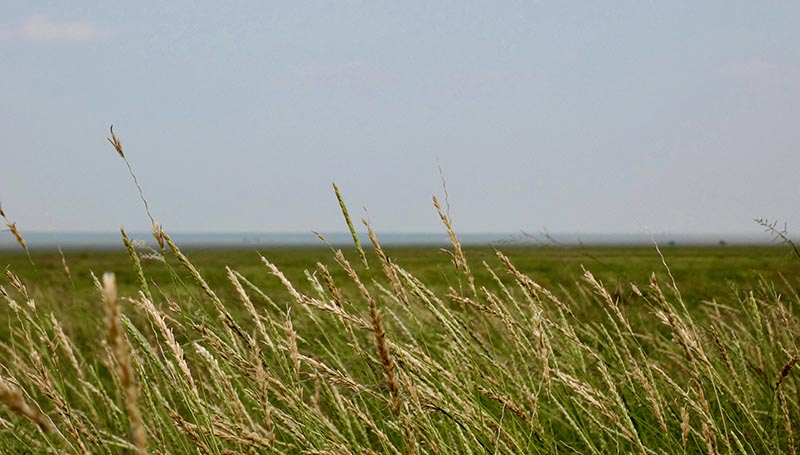
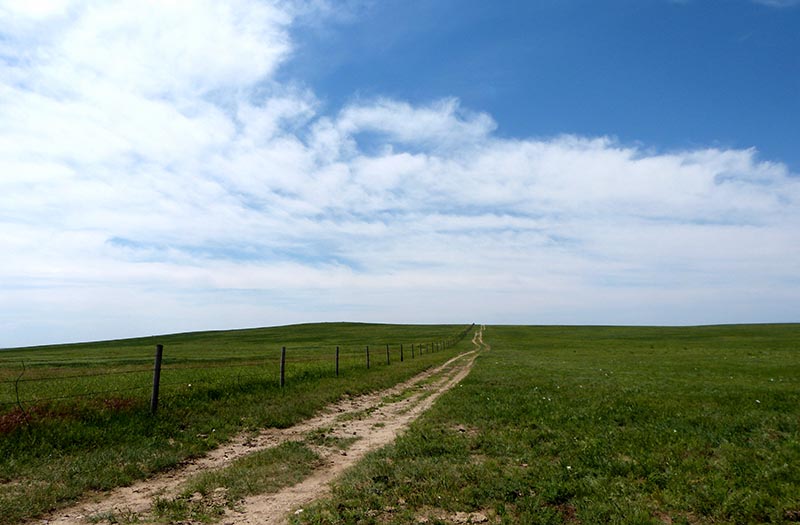
- In the PLJV region, there are about 57 million acres of grassland, including rangeland and restored land enrolled in the Conservation Reserve Program (CRP).
- Historically, about 90% of the region was grassland; now, grasslands make up only 36% of our landscape.
- Grasslands are one of the most threatened ecosystems in North America.
- Much of the native grasslands, especially in the tall- and mixed-grass prairie, were converted to cropland; we estimate that only 1% of tall-grass and 10% of mixed-grass prairie remains.
- Most of the remaining grasslands in the PLJV region are found in the shortgrass prairie; we estimate 45% remains.
- In the southern part of our region, woody plant encroachment and invasive grasses are one of the biggest threats to grasslands.
- In the northern part of our region, invasive cheatgrass and conversion to cropland continue to threaten grasslands.
- Each year, approximately 2% of the grasslands in the PLJV region are lost to woody plant encroachment and 0.88% from conversion to row crop agriculture.
- Grasslands support more than 400 bird species and other wildlife, but grassland birds are experiencing some of the most significant population declines.
- Since 1970, 720 million grassland birds have been lost — that’s a 53% population loss overall.

